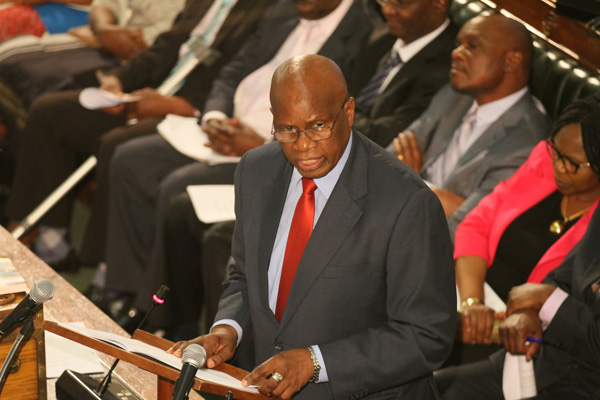
THE 2016 national budget presented recently by finance minister Patrick Chinamasa, has been criticised for falling far too short of addressing a cocktail of women’s needs on the social services front.
BY BYRON MUTINGWENDE
While the year 2015 saw major in-roads towards empowering women, promoting gender equality and equity and promoting community development, women feel more needs to be done on the social service delivery front.
 “The year 2015 has witnessed milestones towards gender mainstreaming. Statistics presented to Parliament by the minister of Finance and economic development Patrick Chinamasa on November 26th show that 2 906 women were trained in various agriculture disciplines, while 2 450 women were sensitised in mining regulations. The two sectors are critical to Zimbabwe’s economic development, but there is need for more effort towards improving the social services encompassing health, education and social welfare and protection,”said Pamela Mhlanga, the director of Zimbabwe Women’s Resource Centre and Network (ZWRCN).
“The year 2015 has witnessed milestones towards gender mainstreaming. Statistics presented to Parliament by the minister of Finance and economic development Patrick Chinamasa on November 26th show that 2 906 women were trained in various agriculture disciplines, while 2 450 women were sensitised in mining regulations. The two sectors are critical to Zimbabwe’s economic development, but there is need for more effort towards improving the social services encompassing health, education and social welfare and protection,”said Pamela Mhlanga, the director of Zimbabwe Women’s Resource Centre and Network (ZWRCN).
Mhlanga’s call for improving the social services sectors comes against a backdrop of unimpressive statistics in the health sector. Gerald Gwinji, the permanent secretary in the Health and Child Care ministry hailed progress made in the current year towards an improved health system, but the statistics still paint a gloomy picture. “According to the 2014 Multiple Indicator Cluster Survey (MICS) report, maternal mortality ratio decreased from 614/100 000 live births to 581/100 000 live births. Child mortality rate decreased by 11% from 84/1 000 live births to 75/1 000 live births, while neo-natal mortality rate per 1 000 live births declined from 31/1 000 live births in 2010 according to the Zimbabwe Demographic Health Survey (ZDHS) to 29/1 000 live births (MICS) 2014 which represents a 6% decline,” Gwinji said.
But despite the above, Mhlanga said the impression given by the government in proffering such figures, was that it was investing heavily in the health sector, yet in actual fact these were figures collated between four and seven years.
She said that the level of health sector investment remained worrisome despite the fact that in April 2001, Zimbabwe and other African Union countries signed the Abuja Declaration, which urged members to set a target of allocating at least 15% of their annual budget to improve the health sector.
Mhlanga bemoaned the fact that the government had not shown willingness to match the donor commitments in the revival of the health sector.
- Chamisa under fire over US$120K donation
- Mavhunga puts DeMbare into Chibuku quarterfinals
- Pension funds bet on Cabora Bassa oilfields
- Councils defy govt fire tender directive
Keep Reading
In 2015 $13,1 million was allocated towards strengthening the provision of maternal and child health services, improving availability of essential medicines, improving immunisation coverage and scaling up the antiretroviral therapy (ART) coverage, but for 2016 it was increased to $13,7m.
“According to the 2015 Budget Statement $155,9m was to be provided by the Global Fund towards combatting HIV/Aids ($124,8m), eradicating TB ($10m), and Malaria($21,1m). Ironically for 2016, Treasury allocated just $1m in support of the Malaria Residual Spraying programme in malaria-prone areas like Matebeleland North and South, Midlands, Masvingo and Mashonaland West.
“This shows that the government is leaving donors to provide the bulk of funding to health care. My advice to the government is that, the starting point should be trying to do this from its own coffers. What if the donors decide to completely pull out tomorrow with such over-reliance on them? That will be a recipe for catastrophe,” Mhlanga said. In 2015, $4,8m was availed for the provision of maternal and child health services, but in 2016 it was increased to $7m.
Treasury was hailed for heeding calls to increase the availability of functional infrastructure in underserved areas, including developing farm/resettlement area health facilities.
The executive director of the Community Working Group on Health (CWGH) said the 2016 budget of $4 billion was crafted in an environment of a very tight fiscal space. “It was, therefore, not surprising to note that the total budget remained almost static with no substantial increases in allocation to ministries. Given the static nature of the budget, the clear message coming from the Ministry of Finance and Economic Development was that of encouraging the ministries to spend within their means. The Ministry of Health and Child Care was “allocated” a total resource package of $411 740 000,” Rusike said.
That amount includes statutory allocation of $25m and other resources from unnamed sources amounting to $55 436 400. While the budget estimates in the Blue Book. There are indications in the national budget statement that some of the funds would be sourced through borrowing from the domestic market and some from the draw-down of the $89m loan from China.
However, what is critical is for the MoFED budget to be transparent on the sources of the ‘other resources’ in order to be clear on whether the MoFED proposed a budget deficit to be financed from domestic borrowing or whether some of the funds are a pledge from donor partners. In terms of the actual vote appropriations, the MoHCC was allocated $330 789 000, which constitute the MoFED’s discretionary appropriation to the MoHCC.
He said MoHCC expenditure up to September 2015 is 79% of what it was allocated for 2015 and it is very unlikely that it would access all the remaining 20%. He added that it would make sense to continue to use the target to assess the MoFED’s budget allocations to MoHCC.
Virginia Muwanigwathe chairperson of the Women’s Coalition of Zimbabwe called on the government to increase funding for procuring essential hospital equipment used in theatres, laboratories and X-ray departments, so as to reduce child and maternal mortality rates.
Muwanigwa hailed the introduction of the Maternal and Child Care budget line in 2012 in the Health Budget ministry and the introduction of the Cancer Advocacy Budget line in 2014 and its continuation for the years 2015 and 2016.
Jane Maponga, programmes coordinator for the Centre for the Development of Women and Children (CDWC) said the budget allocated to the Women Affairs, Gender and Community Development ministry (less than 1% of the overall total budget), was a drop in the ocean in promoting gender equality and equity, considering that women constitute the larger proportion of the population.
Maponga hailed an increase in funding to the Community Development Fund from $50 000 in 2015 to $500 000 in 2016 and the continued funding of the Anti-Domestic Violence Counsel, saying this would go a long way in empowering women.
Founder and director of The Women’s Trust, Luta Shaba weighed in by praising Treasury for taking concrete steps towards implementing the National GBV Strategy through increasing the funding to deal with gender-based violence.
“In 2015 the allocation was $50, 000 which made the situation to deal with GBV difficult. The money for the community development fund will be used to start income-generating projects for women, build women shelters, provide rape testing kits in police stations and for counselling women who experience violence,” Shaba said.











